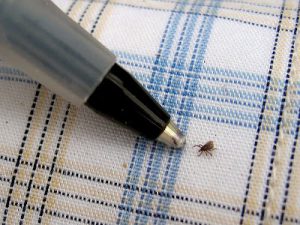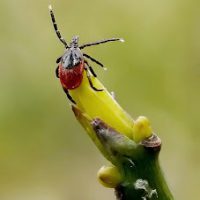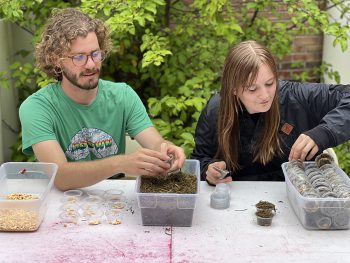According to the Michigan Department of Health and Human Services, in 2024, Lyme disease-carrying ticks have been found in almost every Michigan county.
Now it’s 2025, tick season is in full swing, and this year, a new species has made its way into Michigan. How are MSU’s researchers tackling tick questions and recommending Michiganders protect themselves this tick season?
Understanding Lyme Disease
Stopping the spread of tick-borne illnesses is a major public health challenge, especially in Michigan, where Lyme disease remains a growing concern. Caused by the bacterium Borrelia burgdorferi, Lyme disease can begin with flu-like symptoms and may spread to the joints, heart, and nervous system if left untreated.
“Lyme disease symptoms can range from mild to severe and reduce quality of life. Controlling the spread of Lyme disease-carrying ticks also means controlling other pathogens that are transmitted by the same tick species, so we need to mitigate the spread and reduce the abundance of the blacklegged tick,” says Jean Tsao, PhD, professor of large animal clinical sciences and a blacklegged tick expert.

Tick and Lyme disease researchers are searching for solutions to stop the spread because a human vaccine against Lyme disease has yet to be approved by the US Food and Drug Administration (FDA).
Lyme disease travels from infected rodents, such as mice, into blacklegged ticks when they feed during their larval or nymphal stages. As they mature into nymphs and adults, these ticks feed primarily on deer, but can also bite other animals and people, further spreading the illness.
Controlling the Spread of Blacklegged Ticks and Lyme Disease Through Deer

Since deer are a primary food source for the blacklegged tick, a reduction of that food source would significantly reduce ticks, and as a result, decrease Lyme disease spread.
Some islands, including Monhegan Island in Maine, have been successful in completely removing a deer population to control the blacklegged tick. While other islands never had deer in the first place, like in South Manitou Island, Michigan. On mainland Michigan—and across the continental US—this tactic isn’t possible. State and national borders mean nothing to deer, and decreasing their densities is an enormous ecological and social undertaking.

But researchers have posited a different control for blacklegged ticks—what if you could give the deer an anti-tick medication (acaricide) like many of us do for our dogs and cats?
Tsao is working with her lab at the College to develop an acaricide delivery system tailored for suburban landscapes, starting with a pilot project in south-central Michigan.
“Dr. Rique Campa, my collaborator in Fisheries and Wildlife, and others in the USDA Wildlife Services, Michigan Department of Agriculture and Rural Development, and Michigan Department of Natural Resources developed a distribution method for a deer-targeted anti-bovine tuberculosis vaccine that works well in agricultural areas in the northeastern Lower Peninsula. But the Lyme disease landscape in southern Michigan is increasingly suburban. Previously, hiking and recreation in forested areas where the tick had become established was a big cause of infections in Michigan. But, as the tick has spread in Michigan, many cases can occur just in suburban and exurban neighborhoods because we've created a landscape that's great for white-tailed deer, as well as other animals that participate in the cycles that promote ticks and pathogens,” says Tsao.

Tsao’s lab has delineated and deployed grids where custom-made food products for deer—officially called “drug delivery units” or “DDUs”—are distributed in small amounts throughout. These DDUs are primarily balls of alfalfa, corn, wheat gluten, and molasses, and are highly desirable to deer. They also have a biomarker that allows the lab to tell which deer are eating the DDUs. Ideally, these tasty treats will eventually contain either a Lyme disease vaccine or an oral, systemic anti-tick medication.
The challenge is not just ensuring enough deer consume the DDUs for the system to be effective, but also guaranteeing that they are delivered in a way that does not create opportunities for transmission of pathogens among deer or have unintended negative consequences on other wildlife. The Tsao lab is monitoring the deer population in Meridian Township through trail cameras, and they are working with the Township to track how many drug delivery units have been eaten.
If Tsao and her team find a successful distribution method for these ticks in Michigan, blacklegged ticks will be unable to feed on their primary hosts. This will knock out a portion of the reproductive Lyme disease-carrying blacklegged tick adults when they encounter either an acaracide or a Lyme disease vaccine. Meaning, the tick population and Lyme disease cases should decrease—a huge win for public health!
Asian Longhorned Tick in Michigan
The blacklegged tick isn’t all Michigan has to worry about this season. The Asian longhorned tick has been discovered in the state for the first time on June 13, 2025. This new tick doesn’t carry Lyme disease, but it is a vector for Theileria orientalis and Rocky Mountain Spotted Fever (RMSF). RMSF is of concern for people, while T. orientalis is a threat to livestock. In Michigan, that’s concerning for our cattle.
These ticks spread quickly thanks to parthenogenesis—adult females clone themselves to create offspring rather than needing to mate with males. This allows them to reproduce in large quantities.
Per Rinosh Mani, PhD, DACVM, section chief of bacteriology at the MSU Veterinary Diagnostic Laboratory: “The sheer size of a longhorned tick infestation can sometimes cause severe blood loss in the host animal.” T. orientalis increases the danger to livestock, as certain strains can cause anemia and birthing deficiencies in cattle.
Mani also explains that the longhorned tick is a generalist parasite, allowing it to feed wherever it goes. Its adaptability to the North American climate has likely contributed to its spread in the Midwest.
The Veterinary Diagnostic Laboratory is testing these ticks, and you can check for more information and updates here.
Additionally, Tsao’s The Tick App is a great way to identify ticks you encounter—including the Asian longhorned tick.
Tick safety measures
How can you protect dogs, cats, and yourself this tick season? Tsao gave us her tips and tricks to practice tick safety.
- Give your pets their tick medication. If you’re not sure where to start, consider asking your veterinarian!
- If you are entering a high-risk area—like forests, fields, and parks—wear light-colored clothes, tuck your pants into your boots, and wear long sleeves. You can also consider pre-treating your clothes and gear with permethrin*.
- Conduct tick checks on yourself and your pets before going inside.
- Remove any ticks you find by plucking them from where the head meets your skin.
- Remember that a tick has to bite you for approximately 36 hours to spread Lyme disease, so prompt removal is key!
- Save any ticks that bite you by freezing them so they can be identified in case you develop symptoms.
*A note about permethrin: If you use permethrin products, be mindful to keep them (and any materials treated with them) out of reach of your pets, especially cats. Cats especially can experience toxic effects when exposed to permethrin products via skin contact and/or ingestion (licking their paws or grooming another pet). Symptoms of permethrin toxicosis in cats commonly include muscle tremors and other neurologic signs and would require treatment by a veterinarian.
“We’ve had very robust tick populations this year so far, both the dog tick and the blacklegged tick,” says Tsao. “The reality is that whether there are 2000 ticks in the woods or 1000, people need to take the same precautions. After all, no one wants to be the unlucky person who contracts Lyme disease—even if there are only 50 ticks nearby. So, making tick checks and precautions a habit is the best thing to do.”
